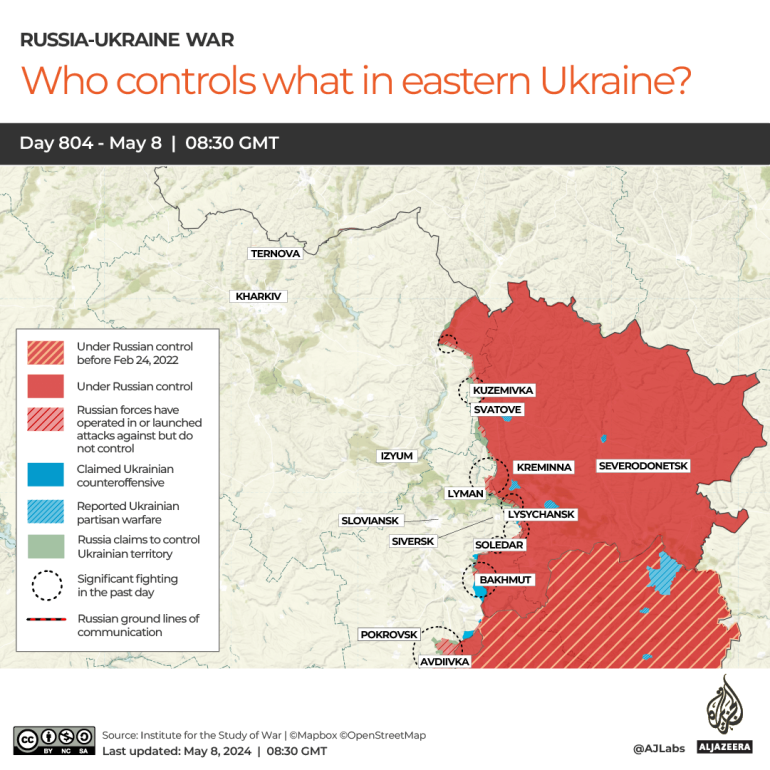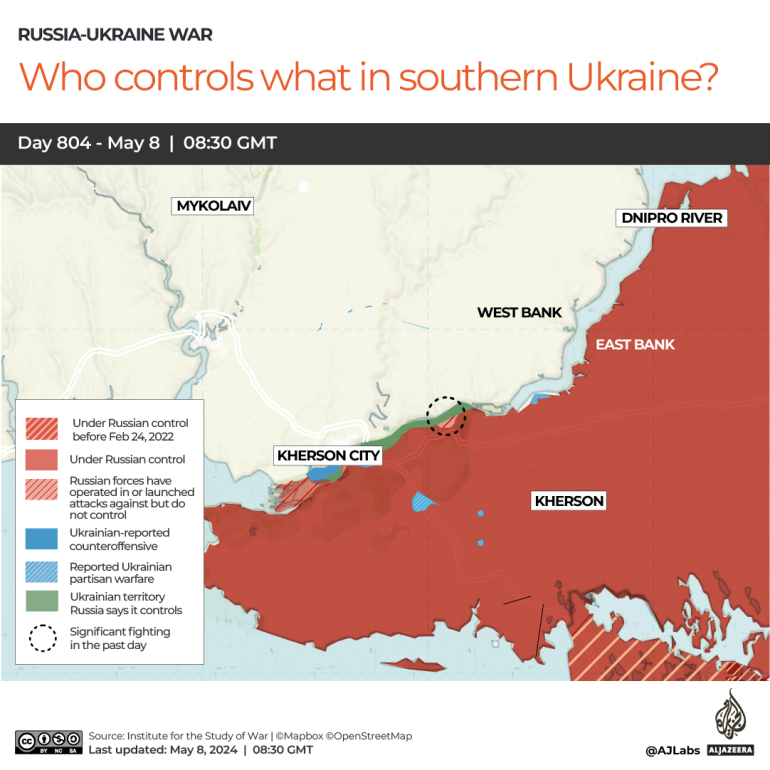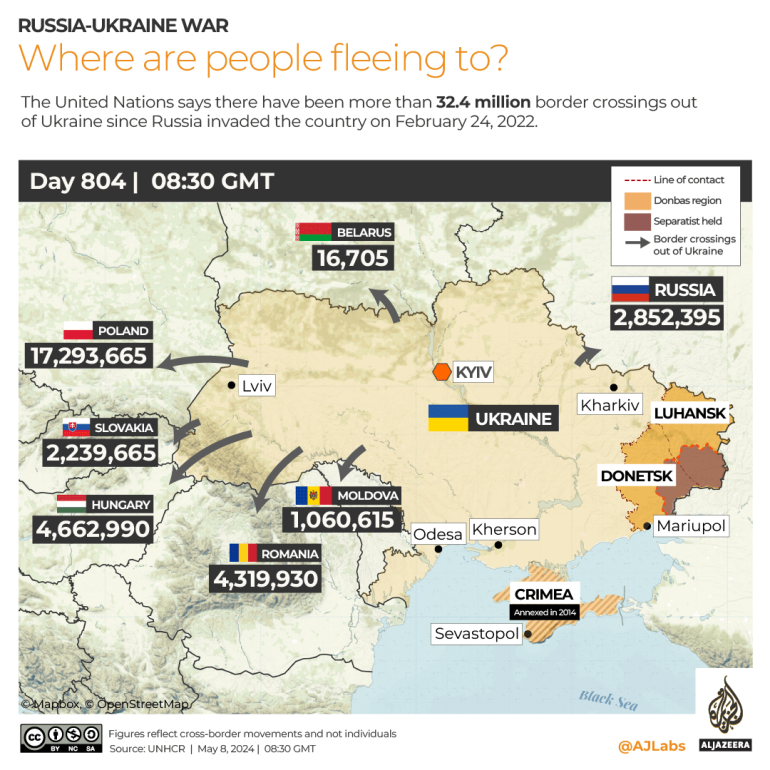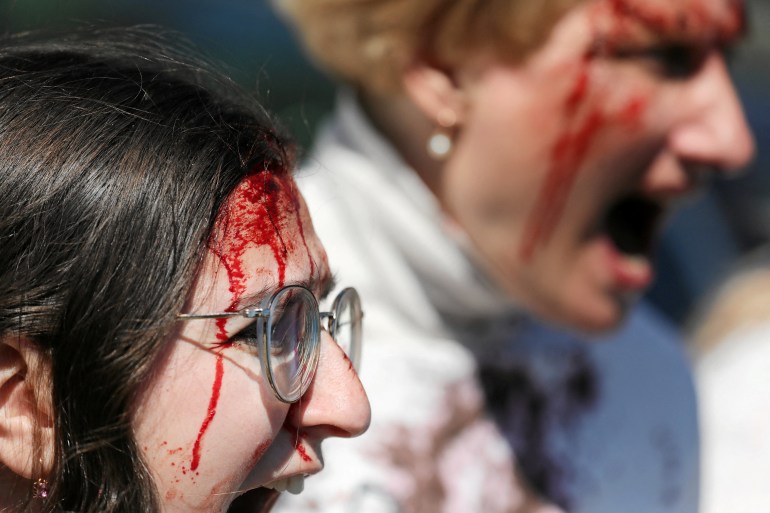Russian forces continued to seize the opportunity to make small tactical advances last week as Ukraine began receiving packages of long-delayed U.S. military aid for the first time in weeks.
Ukraine also reported that Russia is building worrying troop numbers on its northern border and preparing for a possible new front.
Against this tense backdrop, Europe sought to strengthen Ukraine’s own defense industrial base to ensure that political problems among its allies never again impede arms supplies.
Russian forces managed to gain another lead over the Ukrainian defenders in Ocheretyne. The village lies at the western tip of a salient which the Russians gradually built west of Avdiivka after taking that city in February.
They took advantage of a poorly executed replacement of the Ukrainian Defense Battalion to enter Ocheretyne in late April, but encountered stiff resistance.
The Russian Defense Ministry announced that Ocheretyne fell on May 5, Orthodox Easter Sunday.
Satellite images appeared to confirm this, and three days later Russian forces consolidated their capture by advancing four kilometers (2.5 miles) north of the village and extending their gains south.
National Guard Captain Volodymyr Cherniak told The Guardian that Russian forces achieved this by flanking defenses that the Ukrainians took too long to dig because they lacked construction crews.
Russian forces made minor progress as they fought street-to-street in Robotyne, a small town in western Zaporizhzhia that Ukrainian forces recaptured in the counteroffensive last year. And on Monday they swallowed Novoselivske, a village in Luhansk.
Sergei Shoigu, Russia’s defense minister, claimed during a conference call with Moscow’s military leadership that their troops had captured 547 square kilometers of territory in Ukraine since the beginning of the year.
The Institute for the Study of War, a Washington-based think tank, put the figure at 519 square kilometers (200 square miles).
But Russia’s tactical errors were notable.
All week they tried to recapture Nestryga, an island in the Dnipro Delta from which they had harassed Ukrainian forces on the right bank and which Ukraine was able to recapture on April 28. However, they did not succeed in this.
Southern Armed Forces spokesman Dmytro Pletenchuk said at a fundraising event that there were several attacks every day.
“The occupiers have a big obstacle – it is the Dnipro, and to overcome it they are forced to use watercraft… but at the moment they are in an open area and therefore it is quite difficult for them and they are suffering.” Losses,” Pletenchuk said.
A Ukrainian bridgehead on the left bank that has pushed back Russian artillery was even able to expand its position around Krynky by Monday. Here, too, the relentless Russian attacks since the beginning of the year have failed to dislodge the garrison.
Russian forces also failed to capture the strategically important eastern city of Khasiv Yar – a prize Russian President Vladimir Putin reportedly wanted by May 9, the anniversary of Nazi Germany’s surrender 79 years ago.
Even more ominously, the deputy head of Ukrainian military intelligence, Vadym Skibitsky, said Russia may be preparing for a renewed attempt to take Sumy and Kharkiv, two northern cities that it failed to capture along with Kiev in February 2022.

He told The Economist that Russia had concentrated 35,000 troops north of the Ukrainian border in these areas and would send them to Ukraine by the end of May or early June. Ukrainian military observer Kostyantyn Mashovets estimated the number at around 50,000.
Ukrainian parliamentarians have told Al Jazeera that Ukraine has stationed tens of thousands of soldiers in the north of the country, far from the active battle fronts, precisely for this eventuality. During the war, Russian troops stationed in Belarus performed various feints during a deployment, possibly as a diversion. It now appears that Ukraine is taking the threat seriously.
Commander-in-Chief Oleksandr Syrskyii recently said he would send more artillery and tanks urgently needed on active fronts to bolster forces in the north.
But what about the weapons?
Ukrainian officials have repeatedly said they need more Western-supplied weapons to hold out and ultimately drive Russia from Ukrainian soil.
US President Joe Biden signed a supplemental spending bill on April 24 after Congress took six months to approve it. However, there was disagreement over how long it took for $1 billion worth of weapons to reach Ukraine for delivery.
Pentagon spokeswoman Sabrina Singh said supplies reached Ukraine “sometimes within hours, if not within a day or two.”
But on Friday, six days after Biden signed the bill, Ukrainian President Volodymyr Zelensky said: “We are waiting for the weapons to arrive in Ukraine.”
The New York Times reported somewhat obscurely that a first shipment of anti-tank missiles, rockets and 155 mm artillery shells had arrived in Ukraine on April 28th.

Ukraine’s European allies continued to send weapons during the U.S. invasion, but these were not enough to sustain even defensive operations as Europe’s defense industrial base has shrunk since the Cold War.
Ukraine began a strategy to build its own industrial base last December and called on Western investors to speed up the process.
European Union foreign policy chief Josep Borrell attempted to do so on Monday when he brought together 350 Ukrainian and European industry representatives and government officials to promote partnerships backed by EU money.
“Ukraine is a country at war, it is not producing under normal conditions,” Borrell said. “That is why industry representatives need to understand that, firstly, these are new opportunities, secondly, that there is risk and thirdly, that there is financing.”
Ukrainian Foreign Minister Dmytro Kuleba called for a common European defense industrial space to eliminate redundancies and competing weapon systems, as well as long-term industrial contracts and European defense planning.
“If we want to maintain peace in Europe, we must move to a European war economy and industry,” he told the forum virtually. “This is the only way we can contain Russia’s aggression – by showing that Europe has the means to defend itself.”
The Russian threat dawns on Europe
Kuleba was not alone in calling for economic and political change.
French President Emmanuel Macron told The Economist on Friday that Europe faces a triple threat from Russia.
“It is this triple existential risk to our Europe: a military risk and a security risk; an economic risk to our prosperity; an existential risk of internal incoherence and disruption to the functioning of our democracies.”
Macron had hit this nerve a week earlier in a speech at the Sorbonne.
“Our Europe today is mortal,” Macron said. “It can die and that depends solely on our decisions.”
Europe is not equipped to defend itself “when confronted with a power like Russia, which has no inhibitions and no borders,” said Macron. “Europe must be able to defend its interests, with its allies at our side whenever they want, and alone when necessary.”
Speaking to The Economist, Macron also reiterated the possibility of sending French troops to Ukraine, saying this could happen if Russia makes a breakthrough and Ukraine demands it. Kremlin spokesman Dmitry Peskov said the statement was “very important and very dangerous.”

The deputy head of Ukraine’s military intelligence agreed that Europe was not ready to defend itself.
Vadym Skibitsky told Newsweek that Russia could overrun the Baltic states in a week, whereas NATO would need at least ten days to begin the process of coming to their aid.
From NATO’s perspective, the need to help Ukraine has grown with Russia’s threat perception in the rest of Europe.
Four months after Russia’s invasion of Ukraine in 2022, NATO announced it would create a standing force of 300,000 troops to defend its eastern borders, up from about 80,000 today. In January, several NATO defense chiefs sharing similar information said the alliance should prepare for a possible Russian invasion of NATO soil in just five to eight years.
On May 2, NATO’s policymaking body, the Atlantic Council, said NATO allies were “deeply concerned by recent malign activity on allied territory.”
Secretary-General Jens Stoltenberg said a Russian campaign of hybrid activities such as misinformation, espionage and sabotage was already underway in Europe.
The Financial Times on Sunday quoted European intelligence officials as saying that Russia was preparing “covert bombings, arson attacks and damage to infrastructure” in Europe.

